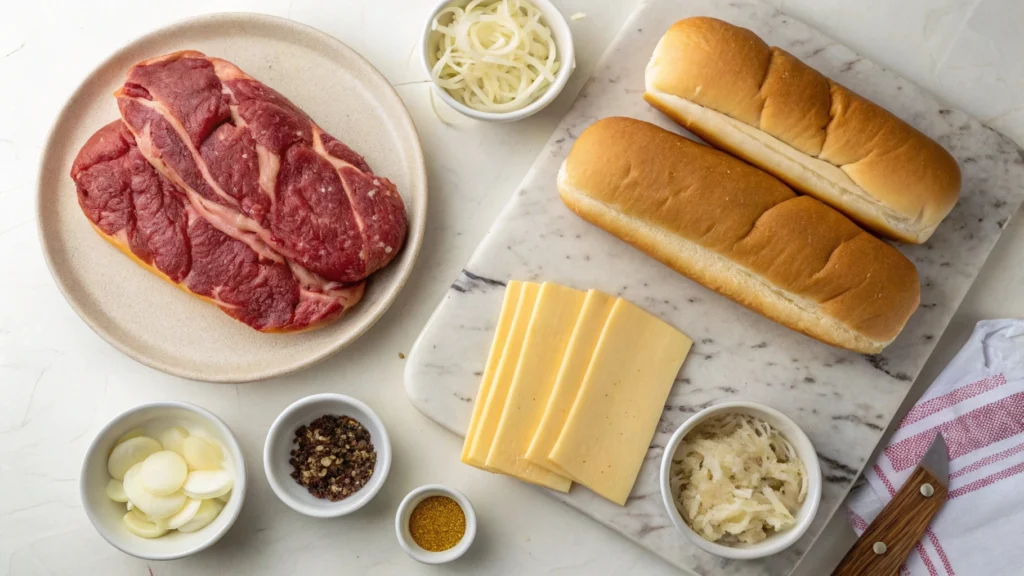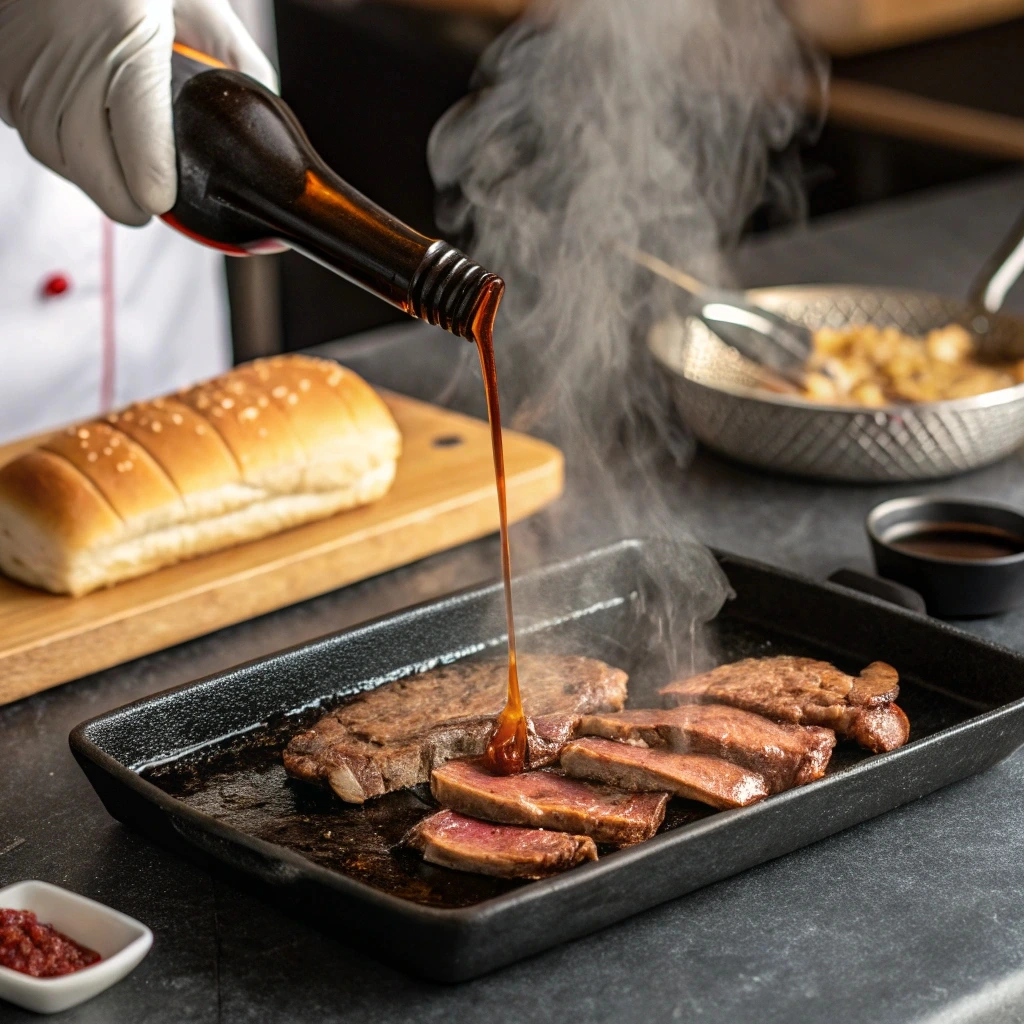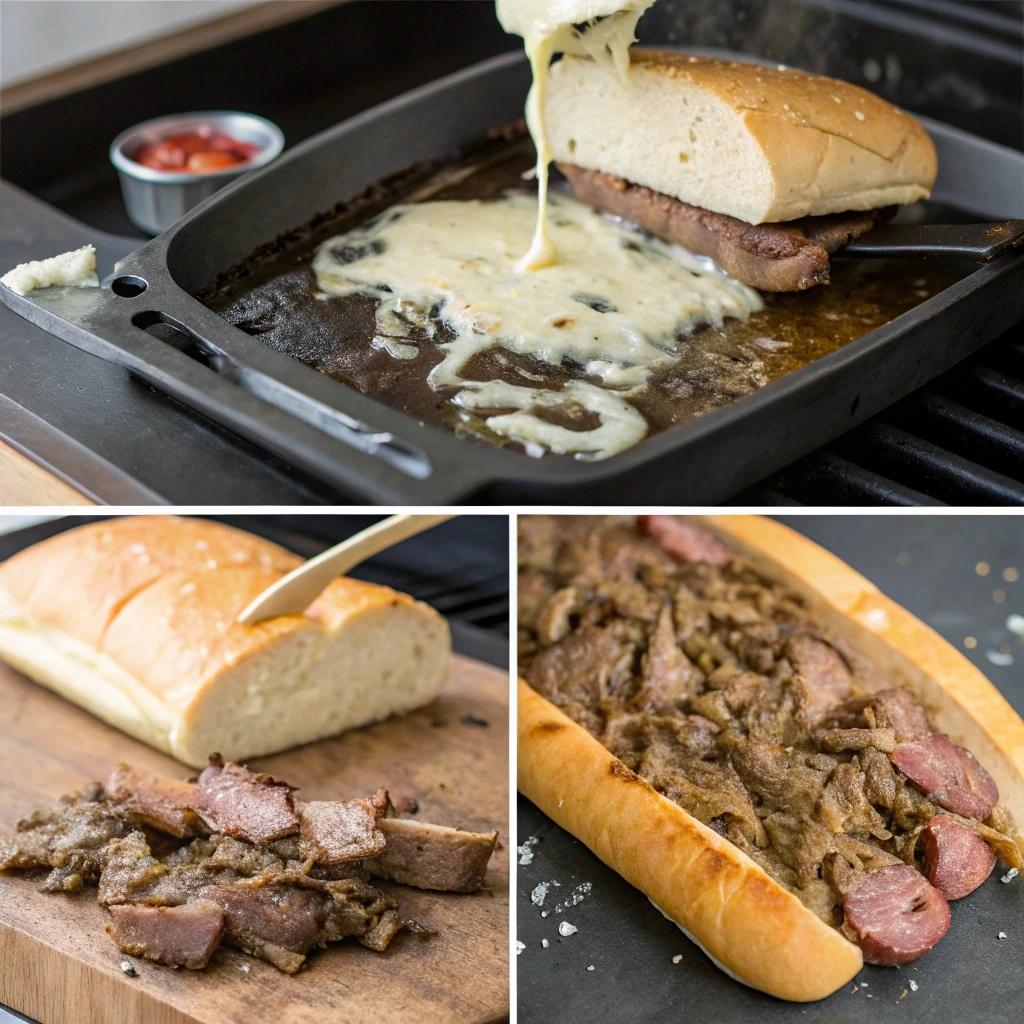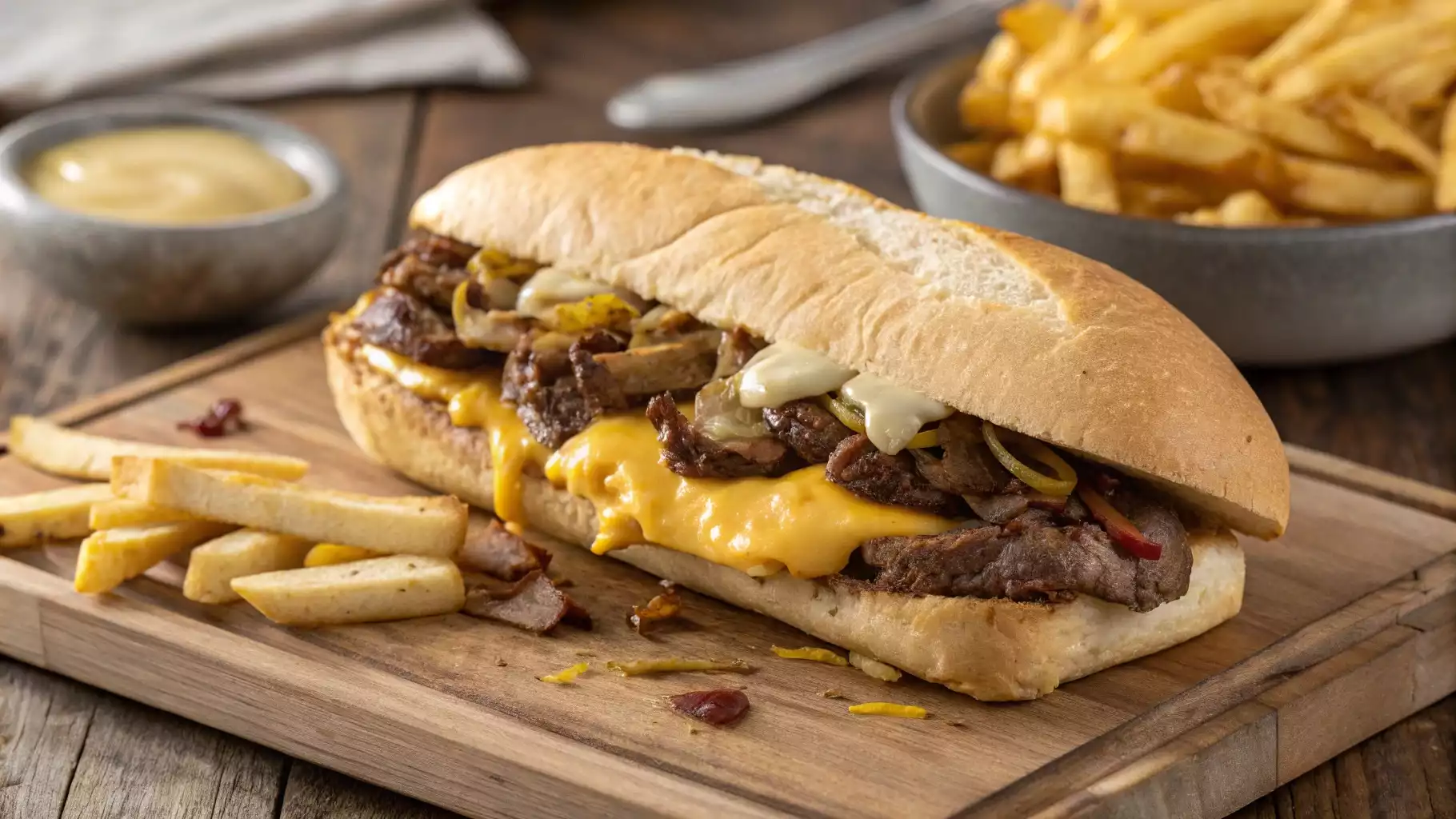What is the secret ingredient in cheesesteak? The cheesesteak is one of the most beloved sandwiches in American cuisine, particularly in Philadelphia, where it originated. It’s a simple yet irresistible combination of thinly sliced beef, melted cheese, and a fresh hoagie roll. But what if we told you that the perfect cheesesteak isn’t just about these well-known ingredients? Many chefs and cheesesteak enthusiasts believe there’s a secret ingredient that sets apart a great cheesesteak from an average one.
This article will explore the history of the cheesesteak, the essential ingredients, and reveal the mystery behind the secret ingredient that gives this sandwich its unforgettable taste. Whether you’re a home cook or just a food lover, this guide will help you understand what truly makes a cheesesteak stand out.
Table of Contents
The History of the Cheesesteak
The Philly cheesesteak is more than just a sandwich—it’s a cultural icon. To understand what makes it so special, we need to explore its origins and how it evolved over time.
Origins of the Philly Cheesesteak
The cheesesteak’s story dates back to the 1930s in Philadelphia. According to legend, Pat Olivieri, a hot dog vendor, decided to grill some thinly sliced beef and put it on an Italian roll for lunch. A taxi driver passing by was intrigued by the smell and asked for one. After taking a bite, the driver suggested that Olivieri should sell this new sandwich instead of hot dogs.
Soon, Olivieri opened Pat’s King of Steaks, one of the most famous cheesesteak restaurants in Philadelphia today. However, the original cheesesteak didn’t include cheese—it was simply thinly sliced ribeye steak on a roll.
Evolution Over Time
The addition of cheese to the sandwich came later. Some say it was introduced by a manager at Pat’s King of Steaks who decided to add provolone, while others claim it was rival restaurant Geno’s Steaks that made cheese a standard ingredient.
Over time, variations of the cheesesteak began to emerge, incorporating different cheeses like American and Cheez Whiz, as well as additional toppings like onions, mushrooms, and peppers. Despite these variations, the classic cheesesteak remains a simple yet flavorful combination of steak, cheese, and bread.
The Traditional Cheesesteak Ingredients
A cheesesteak may seem simple at first glance, but every ingredient plays a crucial role in creating its signature taste and texture. Let’s break down the core components that make a true Philly cheesesteak.
The Role of Steak
The heart of a cheesesteak is the steak itself. The best cheesesteaks use thinly sliced ribeye because of its marbling and tenderness. When cooked on a flat-top grill, the fat in the ribeye melts, infusing the meat with rich flavor.
Some restaurants and home cooks experiment with other cuts like sirloin or even shaved beef, but ribeye remains the gold standard for an authentic taste. The meat should be cooked on high heat and chopped finely to create the ideal texture for layering on a hoagie roll.
Choosing the Right Cheese
Cheese is what sets a cheesesteak apart from a basic steak sandwich. There’s an ongoing debate about which cheese is the best:
- Provolone – A traditional choice that provides a mild, slightly tangy flavor.
- American Cheese – Known for its creamy texture and mild taste, it melts well and blends seamlessly with the steak.
- Cheez Whiz – A processed cheese sauce that adds a salty, gooey consistency. Some purists argue that a real Philly cheesesteak isn’t complete without it.
While preferences vary, many Philadelphia locals argue that Cheez Whiz is the true Philly-style cheese for a cheesesteak. However, provolone and American cheese remain popular choices.
The Perfect Bread
A cheesesteak is nothing without the right bread. The traditional choice is a soft hoagie roll that’s slightly crisp on the outside but soft enough to absorb the juices from the steak and melted cheese.
Philadelphia’s Amoroso rolls are widely recognized as the best option for an authentic cheesesteak. Their light, airy texture holds the meat and cheese together without overpowering the flavors.
Other factors like toasting the bread lightly or spreading a thin layer of butter can enhance the overall taste.

The Secret Ingredient in Cheesesteak
While steak, cheese, and bread are the foundation of a great cheesesteak, many top chefs and food enthusiasts believe that a secret ingredient is what takes it to the next level. But what exactly is this mystery component? Let’s uncover the hidden flavors that make some cheesesteaks unforgettable.
What Makes a Cheesesteak Unique?
If you’ve ever tasted a truly exceptional cheesesteak, you might have noticed something special—an extra burst of umami, richness, or spice that makes the flavors stand out. While most cheesesteaks stick to the traditional three ingredients, the best ones often include a hidden element that enhances the taste without overpowering the classic flavors.
The Hidden Flavor Enhancer
There isn’t just one secret ingredient—different cheesesteak makers have their own special twist. However, some of the most commonly used “secret” ingredients include:
- Worcestershire Sauce – A splash of this savory sauce adds depth and enhances the natural beefy flavor of the steak. Some chefs mix it directly into the meat while cooking.
- Garlic Butter – Brushing the hoagie roll with a thin layer of garlic butter before toasting gives it a richer, slightly nutty taste.
- Soy Sauce – A surprising addition, soy sauce brings out the umami flavor in the steak, making it more flavorful and juicy.
- Onion Juice or Powder – Some places use a small amount of onion juice or powder to subtly boost the caramelized onion flavor.
- Hot Sauce or Cayenne Pepper – A slight kick of heat can enhance the cheesesteak’s taste without making it too spicy.
- Beef Stock Reduction – Some chefs drizzle a bit of reduced beef stock onto the steak to intensify its natural flavor.
The Controversy Around the Secret Ingredient
In Philadelphia, cheesesteak purists argue that no extra ingredient should be added. They believe that a true Philly cheesesteak should only include steak, cheese, and bread—no sauces, no seasonings beyond salt and pepper.
However, many modern cheesesteak shops experiment with different ingredients to create signature flavors. Some even claim that their secret ingredient is what makes their cheesesteak the best in the city.
Whether you prefer a classic cheesesteak or one with a special twist, the secret ingredient is all about enhancing the natural flavors without overpowering them.
How to Make the Perfect Cheesesteak
Now that we’ve explored the secret ingredient, it’s time to put everything together and create the perfect cheesesteak at home. A great cheesesteak isn’t just about the ingredients—it’s also about the technique. Follow these steps to ensure your homemade cheesesteak rivals those from the best sandwich shops in Philadelphia.
Step 1: Selecting the Best Meat
The key to a great cheesesteak is using the right cut of beef. The best choice is ribeye steak, known for its perfect balance of tenderness and fat. If ribeye is too expensive, sirloin is a good alternative, but ribeye provides the most authentic taste.
How to Prepare the Steak:
- Place the steak in the freezer for 30–40 minutes before slicing. This makes it easier to cut into thin strips.
- Use a sharp knife to slice the steak as thinly as possible. Some butchers can even shave the steak for you.
- Season lightly with salt and pepper—avoid using too many spices, as they can overpower the steak’s natural flavor.
- If you’re using a secret ingredient like Worcestershire sauce or soy sauce, mix a small amount into the meat before cooking.
Step 2: Cooking the Steak to Perfection
A flat-top griddle or cast-iron skillet is the best cooking surface for a cheesesteak. The high, even heat helps create the perfect sear while keeping the meat tender.
Cooking Instructions:
- Heat the griddle or pan to medium-high heat.
- Add a little neutral oil (such as vegetable or canola oil) to prevent sticking.
- Add the thinly sliced steak, spreading it evenly across the pan.
- Cook for 2–3 minutes, then start chopping the meat with a spatula to break it into small pieces.
- If using onions, add them at this stage and cook until caramelized.
- Mix in a small amount of your secret ingredient to enhance the flavor.
Step 3: Melting the Cheese Correctly
The way you melt the cheese can make or break your cheesesteak. Instead of just placing slices on top, follow these techniques for maximum melt and flavor:
- Provolone or American Cheese – Place slices over the hot meat and let them melt naturally. Covering the pan with a lid for 30 seconds helps the cheese melt evenly.
- Cheez Whiz – If using Cheez Whiz, warm it separately in a saucepan or microwave. Spread it directly on the hoagie roll before adding the steak.
Step 4: Preparing the Bread
The hoagie roll is just as important as the meat and cheese. Use a fresh, slightly crusty roll that can absorb the juices without becoming soggy.
Bread Preparation Tips:
- Toast the bread lightly for extra crunch.
- For a richer flavor, brush the inside of the roll with garlic butter before toasting.
- If using Cheez Whiz, spread it on the bread before adding the steak.
Step 5: Assembling the Perfect Cheesesteak
- Scoop the cheesy, flavorful steak mixture onto the toasted hoagie roll.
- Press down lightly to let the juices soak into the bread.
- Serve hot, with no extra condiments—a true Philly cheesesteak doesn’t need ketchup or mayo!


Regional Variations and Unique Twists
While the classic Philly cheesesteak consists of just steak, cheese, and a hoagie roll, different regions and chefs have put their own unique spin on this beloved sandwich. Let’s explore some of the most popular variations and the unique ingredients that make them stand out.
Different Cheese Options
Although Cheez Whiz, American cheese, and provolone are the most common choices, many restaurants experiment with other cheeses to create new flavors.
- Mozzarella – Adds a creamy, stretchy texture similar to a Philly pizza steak.
- Pepper Jack – Gives the cheesesteak a spicy kick.
- Swiss Cheese – Provides a mild, nutty flavor that complements caramelized onions.
- Blue Cheese – Adds a sharp, tangy twist for those who love bold flavors.
Unique Toppings and Additions
While traditionalists prefer a simple cheesesteak, some variations incorporate extra toppings to enhance the sandwich.
- Caramelized Onions – A staple in many cheesesteak recipes, they add a natural sweetness that balances the richness of the steak and cheese.
- Mushrooms – Sauteed mushrooms give the sandwich an earthy, umami flavor.
- Peppers – Some cheesesteaks include green, red, or banana peppers for added texture and mild heat.
- Jalapeños – For those who love spice, sliced jalapeños bring heat and extra flavor.
- Bacon – Adding crispy bacon takes the cheesesteak to another level of indulgence.
Regional Cheesesteak Variations
Different cities and regions have put their own local twist on the cheesesteak, creating exciting versions of the classic sandwich.
1. The Philly Pizza Steak
This version combines a cheesesteak with marinara sauce and mozzarella cheese, making it taste like a steak-filled pizza. It’s often toasted in the oven for extra crispiness.
2. The Cheesesteak Hoagie
A fusion of a cheesesteak and an Italian hoagie, this variation includes lettuce, tomatoes, and mayonnaise, giving it a fresh contrast to the rich steak and cheese.
3. The California Cheesesteak
Popular on the West Coast, this version often includes avocado, lettuce, and tomatoes, bringing a lighter, fresher taste to the traditional cheesesteak.
4. The Buffalo Cheesesteak
For those who love heat, this variation features Buffalo sauce and blue cheese dressing, giving it the flavor of Buffalo wings in sandwich form.
5. The Texas Cheesesteak
A Southern twist that incorporates barbecue sauce, grilled onions, and smoked cheddar cheese for a bold, smoky flavor.
Vegetarian and Vegan Cheesesteak Alternatives
For those who don’t eat meat, there are plenty of plant-based cheesesteak options that still capture the essence of the classic sandwich.
- Portobello Mushroom Cheesesteak – Thick-cut mushrooms replace steak for a hearty, umami-packed alternative.
- Seitan or Tofu Cheesesteak – Seitan, a wheat-based protein, mimics the texture of beef, while tofu absorbs the flavors of the seasoning and cheese.
- Vegan Cheese Substitutes – Dairy-free cheese alternatives like cashew-based or soy cheese melt well and provide a creamy texture.
FAQs About Cheesesteak
To wrap up our deep dive into cheesesteaks, let’s answer some of the most frequently asked questions about this iconic sandwich.
1. What kind of steak is best for a cheesesteak?
The best cut of beef for a cheesesteak is ribeye. It’s well-marbled, meaning it has enough fat to keep the meat juicy and flavorful when cooked. Some people use sirloin or top round as an alternative, but ribeye remains the gold standard for an authentic Philly cheesesteak.
2. What cheese is most commonly used?
The three most popular cheese choices for a Philly cheesesteak are:
- Cheez Whiz – The most iconic and traditional option, known for its gooey, creamy texture.
- Provolone – A mild, slightly tangy cheese that melts well.
- American Cheese – A soft, creamy cheese that blends smoothly with the steak.
3. How important is the bread in a cheesesteak?
The bread is just as important as the steak and cheese. The best cheesesteak rolls are soft hoagie rolls, preferably from Amoroso’s Bakery in Philadelphia. These rolls are light and slightly crusty on the outside while remaining soft enough to absorb the juices from the steak and cheese.
4. What’s the most debated secret ingredient?
Many cheesesteak lovers argue about whether Worcestershire sauce, garlic butter, or soy sauce should be added. Some chefs believe these ingredients enhance the flavor, while purists insist that a true cheesesteak should only have steak, cheese, and bread.
5. Can you make a cheesesteak at home?
Yes! To make a cheesesteak at home, you need:
- Thinly sliced ribeye steak
- Cheez Whiz, provolone, or American cheese
- A soft hoagie roll
- A flat-top griddle or cast-iron skillet for the best cooking results
By following the steps outlined earlier in this article, you can make a restaurant-quality cheesesteak right in your kitchen.
6. What’s the best way to cook cheesesteak meat?
The best way to cook cheesesteak meat is on a flat-top griddle or cast-iron skillet over medium-high heat. The steak should be cooked quickly, chopped finely with a spatula, and mixed with the cheese for the perfect texture. Avoid overcooking, as this can dry out the meat.
Conclusion
The Philly cheesesteak is more than just a sandwich—it’s a cultural icon with a rich history, a loyal following, and countless variations. While the classic recipe consists of thinly sliced ribeye, melted cheese, and a soft hoagie roll, many people believe that a secret ingredient is what takes a cheesesteak from good to unforgettable.
Some of the most popular secret ingredients include Worcestershire sauce, garlic butter, soy sauce, and beef stock reduction, all of which enhance the natural flavors of the steak. However, traditionalists argue that a true Philly cheesesteak should remain simple and unaltered.
Regardless of personal preferences, the key to a perfect cheesesteak lies in:
- Using high-quality ribeye steak for its rich marbling and tenderness.
- Choosing the right cheese, whether it’s Cheez Whiz, provolone, or American cheese.
- Cooking the steak on a flat-top griddle for the best texture and flavor.
- Serving it on a soft hoagie roll, preferably an Amoroso roll.
From regional variations to vegan alternatives, the cheesesteak continues to evolve while remaining one of America’s most beloved sandwiches. Whether you prefer it classic or with a twist, one thing is certain: a great cheesesteak is all about simple ingredients, great technique, and bold flavor.
Now that you know the secrets behind the perfect cheesesteak, it’s time to try making one yourself! Would you go for the traditional version, or do you have a special secret ingredient of your own? 😋

